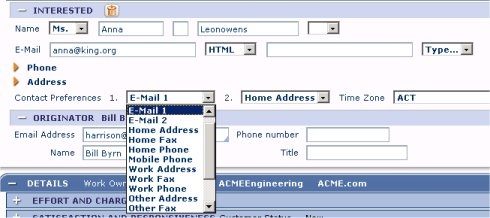A work object may identify one or many parties who are interested, affected by, or somehow involved in the matter, including the originator. When correspondence about the work object is sent to a party, the system attempts to use a medium recorded as that user's contact preference.
For example, some parties may prefer to receive correspondence as e-mail. Others may prefer a printed postal letter.
Work object forms may capture multiple addresses and other ways to communicating with parties, such a work and home phone numbers, e-mail addresses, fax numbers, and so on. For example, the standard HTML rule Data-Party.PartyContact allows users to record three preferences (Data-Party.pyResponseMode1, pyResponseMode2, and pyResponseMode3) for an interested party. These properties accept a value from a drop-down list, as seen in this portion of a PegaSample form:

When selecting a correspondence rule, the system chooses
from only those with a correspondence type that's
compatible with one of the recipient's preferences. For
example, if Anna Leonowens prefers Email 1 and
Work Fax for correspondence, the Process Commander
application looks for correspondence rules with
email or fax as the
Correspondence Type.
After you select a contact preference, the
PartyContact HTML rule makes the corresponding
address fields required. For example, you can't indicate
that Home Address is the first preference without
supplying a home address.
For Process Commander users (when identified as a party of the Data-Party-Operator class), the contact preference is always e-mail.
|
|
correspondence type, originator, sample application, work party |
|
|
About
Correspondence Types
Correspondence concepts and terms |